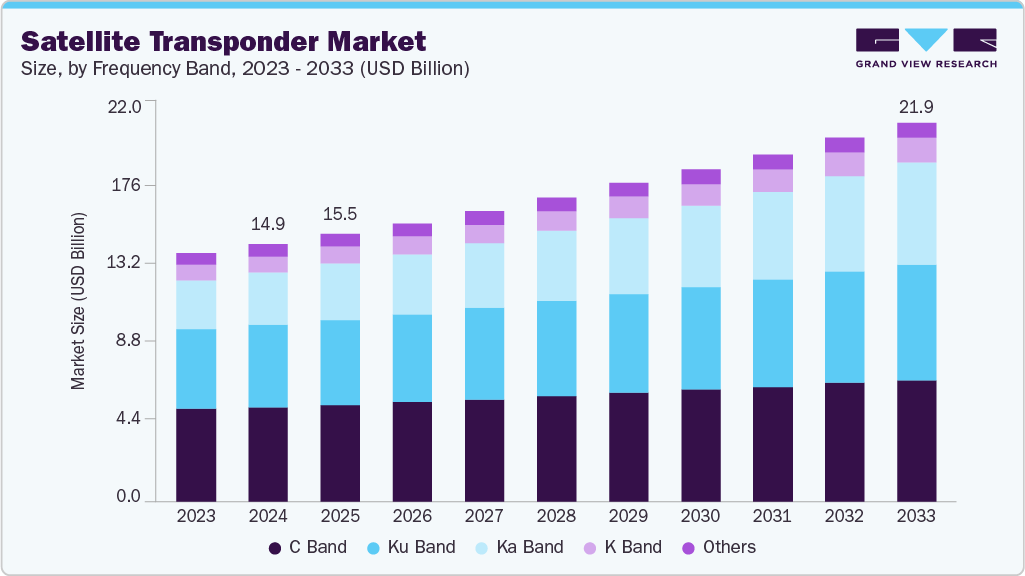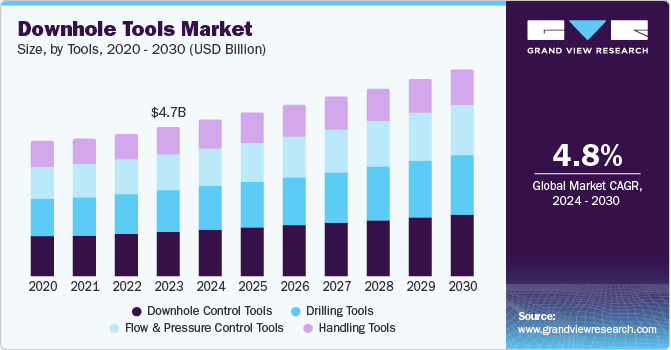Satellite Transponder Market Size, Share & Trends Analysis growing at a CAGR of 4.5% from 2025 to 2033

The global satellite transponder market size was estimated at USD 14,911.0 million in 2024 and is expected to reach USD 21,987.2 million in 2033, growing at a CAGR of 4.5% from 2025 to 2033. This growth is primarily driven by increasing demand for high-throughput satellite services, expanding DTH (Direct-to-Home) broadcasting subscriptions, and growing need for secure and reliable satellite communication in defense and aviation.
Key Market Trends & Insights
- North America dominated the global satellite transponder market with the largest revenue share of 41.5% in 2024.
- The satellite transponder market in the U.S. led the North America market and held the largest revenue share in 2024.
- By frequency band, C Band led the market and held the largest revenue share of 36.7% in 2024.
- By service, the leasing segment held the dominant position in the market and accounted for the leading revenue share of 77.7% in 2024.
- By satellite platform, geostationary earth orbit satellites (GEO) segment held the largest revenue share of 68.7% in 2024.
Market Size & Forecast
- 2024 Market Size: USD 14,911.0 Million
- 2033 Projected Market Size: USD 21,987.2 Million
- CAGR (2025-2033): 4.5%
- North America: Largest market in 2024
- Asia Pacific: Fastest growing market
Request a free sample copy or view report summary: https://www.grandviewresearch.com/industry-analysis/satellite-transponder-market-report/request/rs1
The global satellite transponder market is largely driven by the rising demand for high-throughput satellite (HTS) services and the growing penetration of DTH (Direct-to-Home) broadcasting. The increasing need for uninterrupted broadband and telecommunication connectivity in remote and underserved areas has significantly accelerated the deployment of satellite transponders.
Additionally, rapid advancements in satellite communication technology, including the adoption of high-capacity Ka-band and Ku-band transponders, are boosting transmission efficiency and expanding service reach. The market is also benefiting from rising investments in defense, surveillance, and navigation systems. Governments and private players enhance infrastructure for space-based communication and IoT integration. Together, these factors contribute to steady market growth globally.
A notable trend in the satellite transponder market is the rising demand for high-speed internet and broadband connectivity in remote and rural areas. The growing global consumption of digital television and direct-to-home (DTH) broadcasting is significantly influencing market dynamics. Smart TV adoption rises, and consumers demand high-definition and ultra-high-definition content, broadcasters increasingly depend on satellite transponders to deliver consistent and high-quality transmissions.
Furthermore, the rapid deployment of low-earth orbit (LEO) satellite constellations is transforming the industry landscape. LEO satellites offer reduced latency and high data throughput, creating new opportunities for cost-effective transponder solutions. Leading companies in the satellite transponder sector are actively investing in research and development to support innovations.
Strategic alliances, partnerships, and satellite sharing agreements are being formed to enhance market presence and optimize network coverage. Companies are also focusing on vertical integration and expanding their offerings to include end-to-end satellite communication services. Additionally, there’s a growing emphasis on sustainable and cost-efficient transponder systems to support next-generation satellite networks, which is helping firms stay competitive and meet evolving connectivity demands worldwide.
Frequency Band Insights
The C band segment accounted for the largest revenue share of over 36% in the satellite transponder industry in 2024. The leading position of this segment is driven by its widespread use in broadcasting and telecommunications, making it ideal for stable signal transmission. C Band transponders are extensively utilized for satellite television, radio, and data communications. The increasing demand for reliable and wide-coverage satellite services across emerging markets and rural areas continues to boost the adoption of C Band frequencies. The growing need for uninterrupted connectivity in critical applications such as defense communication and disaster recovery further reinforces the demand for C Band transponders.






